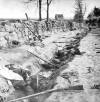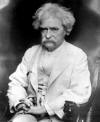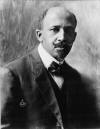| AMS 100: Introduction To American Identity and Culture |
IV. American Culture (continued)
C. Early Immigrant Groups & the American Frontier 1600-1890
1. Immigrant groups: Coming To America
American immigrant groups in the early days of the Colonial Period (1607-1788) and the Young Republic (1788-1810) the dominant groups were English, German, Scot-Irish, French, and African. These cultures brought their own folk traditions, church music and minimal fine arts. The Scot-Irish tended to be out in the frontier and adapt American Indian lifestyles out of necessity. These immigrants created a new hybrid European American culture. In some cases these earliest groups disconnected their immigrant roots and just consider themselves Americans. The core of this is an emphasis of English influences, reflected in the fact that English became the 'official' language and most of America's land and weights/measures are rooted in English conventions. African people, mostly slaves, had their own social fabric and culture stripped from them. They too adapted some American Indian culture but essentially had to build a whole new culture in America. The oral traditions from Africa, European goods, and American Indian food were fused into an new culture, African American.
In the visual arts much of the early folk arts reflect the early pioneer experience and necessity to make do with minimal imports or manufactured goods. The American Folk Art Museum in New York feature a good collection of early American folk art.
| Limner painting: These were done by amateur
painters the would travel about the countryside
and paint family portraits on pieces of wood. This was very popular in New England |
|
| American quilt: These began as patchwork utility items but began to carry history and messages of the makers family. Quilting Bees became important social gatherings for women on the frontier was popular among various ethnic group all the way over the Oregon Trail to the West Coast | |
| Weather vane: This painted copper weather vane is an ornate version of a common fixture on homes or barns across the country. Most were a human figure or an animal like the more common rooster. | |
| 'Kentucky Rifles' were actually made in Pennsylvania by German craftsmen | |
| Southern Face Jugs were to keep moonshine and were made were there was plentiful clay especially in North Carolina and Georgia | |
| Shaker furniture was simple but well designed. The Shakers started in upstate New York and move throughout the country with rather restricted communities. Their furniture is still copied today. |
Early founding fathers tried to establish intellectual institutions to quell European criticism that Americans were crude and unsophisticated. The Pennsylvania Academy of Fine Arts was one of those early institutions and was established in 1805 by Charles Willson Peale. PAFA became a site for exhibitions, school and collections of American art. Peale started out as a limner and traveled about painting portraits, but went on to formal training as a painter and did formal portraits of more well to do clients. Later in the 19th century other universities trained artists and the Smithsonian Institution, Washington D.C. took on the task of housing the nations art. Eventually other urban centers like Boston and New York vied to exhibit various genres of fine art. The Metropolitan Museum of Art in New York (The Met) has become one of the largest and prestigious museums in the world. Much of the fine art of the early immigrant groups (Art Profile 1) comes from Europe or European Influences.
Likewise, literature tends to be dominated by folk stories elicited from the frontier experience. Early literature is derived from England to include poetry and the novel. Eventually, American schooled writers were able find specific American experiences to cover in their writings. Initially, death and disease are a dominate theme in the 'gothic' tradition.
From our American Songbook the first entry Song #1 "Amazing Grace" reflects our conflict with the ideal and real that has been popular in tough times with a new crisis and emergence after 9-11. Amazing Grace is typical of many of our early songs like "Barbara Allen" and "House of the Rising Sun" in that they combine European and American elements to form a synthesis to create something reflective of our American experience.
In the American Songbook, Song #2 "Yankee Doodle" reflects the beginnings of an identity crisis for American immigrant groups.
2. Manifest Destiny and Western Frontiers
After the Revolutionary War 1776-1789 the American frontier rapidly expanded west over the Cumberland Gap. Anythingand migrated south from Pennsylvania along the Wagon Road through the Shenandoah Valley. Many were promised land after the Revolutionary War and most land pensions paid to veterans and their families were in Virginia, the Carolinas and later Kentucky or Ohio. The U.S. government had entered into treaties with various Native American groups, but broke them all with increased immigrants and land needs. Farming, especially with cash crops like tobacco, depleted the soil and so many established farmers left the East for 'The West'. Many such as the Scot-Irish ignored federal regulations and treaties as they forced Indian families off their land, often with violent consequences. The federal government, especially Southern presidents turned a blind eye as newspapers used a Manifest Destiny justification for continued displacement of Native Americans. The idea came from the old testament scriptures that gave the Israelites the right to the promised land because of the right religion and the promise that they would put the land to better use. In America, Manifest Destiny was given greater strength by denigrating Eastern Woodland culture as merely primitive hunting and gathering rather than village farmers, which they were.
Various Europeans such as the English, Dutch, German and
Swedes settled along the Atlantic Seaboard. The Scot-Irish, Welsh and Irish were
forced to settle out on the frontier. Eventually, many went south into the
Western Piedmont of Virginia, the Carolinas and Georgia. This
established the 'Great Wagon Road' through the Shenandoah Valley
 and later some of the same people went West over the Cumberland Gap into
Tennessee and Kentucky. The Western Frontier continued to spread west as
settlers moved beyond the Midwest to Oregon, Washington Territory, California
and the Southwest. The conquest of new territory, leaving home, wandering, and
the attraction of the 'Promised Land' in American Destiny was a common
theme of the fine that initially followed "Romantic" themes in the art of the early 19th century
(Art Profile 2).
and later some of the same people went West over the Cumberland Gap into
Tennessee and Kentucky. The Western Frontier continued to spread west as
settlers moved beyond the Midwest to Oregon, Washington Territory, California
and the Southwest. The conquest of new territory, leaving home, wandering, and
the attraction of the 'Promised Land' in American Destiny was a common
theme of the fine that initially followed "Romantic" themes in the art of the early 19th century
(Art Profile 2).
As the 'Young Republic' was growing in the early 1800s the
British decided to take back their colony to engulf the nation in the War of
1812. The British, by 1814, succeeded in burning the capitol in Washington D.C.
and proceeded to bombard Baltimore up the Potomac River. The citizens of
Baltimore dug in at Ft. McHenry.
 After
an all night siege, a young merchant in a ship in the harbor saw a huge
flag still raised in the early morning. His name was Francis Scott Key and
he composed our Song #3 " Star Spangled Banner"
that primarily established the image of our 'Stars and Stripes' American flag.
However, the song did not become our official National Anthem until 1931.
After
an all night siege, a young merchant in a ship in the harbor saw a huge
flag still raised in the early morning. His name was Francis Scott Key and
he composed our Song #3 " Star Spangled Banner"
that primarily established the image of our 'Stars and Stripes' American flag.
However, the song did not become our official National Anthem until 1931.
Fundamental differences emerged between the New England's small
farms and industries and the South's
need for labor to maintain its large plantations. Early on the South had
refused to abide by Federal treaties in dealing federal treaties with the Five Civilized Tribes and
President Jackson pushed through the Indian Removal Act of 1830. This forced Indians
to the Indian Territory, West of the Mississippi River which resulted in the Trail
of Tears. An abolitionist movement in the North fell on deaf ears and
led to a Federal vs. State authority crisis that drew our nation into secession and
Civil War.
 The Civil War marked a crisis in the United States that is visible
in artistic styles that became more "Realistic" and reflective of our personal
struggles as a people. The Civil War took such a toll on lives, property and
well being that the potential for loss became a theme in novels like Red
Badge of Courage and songs such as
Song # 4 "When Johnny Comes Marching Home".
For the first time the realism of war was portrayed in actual photographs
revealing a stark landscape of death and destruction.
The Civil War marked a crisis in the United States that is visible
in artistic styles that became more "Realistic" and reflective of our personal
struggles as a people. The Civil War took such a toll on lives, property and
well being that the potential for loss became a theme in novels like Red
Badge of Courage and songs such as
Song # 4 "When Johnny Comes Marching Home".
For the first time the realism of war was portrayed in actual photographs
revealing a stark landscape of death and destruction.
D. American Progressive Movement, Industrialization, Imperialism 1890-1939
1. Gilded Age and WWI
After the Civil War the North plundered the South and many went
West to expand the frontier into the Plains and beyond. America's resources,
mineral, timber, immigrants, etc. were applied to increasing industrial
development with improvements rail and shipping. Eventually, the frontier was
closed in 1890 and a conservation movement emerged to preserve/conserve what was
left. However, by the turn of the century with the Spanish-American War America
was part of a Gilded Age (a term from Mark Twain's novel satirizing material
excess and the quest for wealth) and sought to become a world power. The 'Great
White Fleet' of US Naval might sailed the world between 1907-09.
 Great
White Fleet Great
White Fleet |
|
As industrialization grew and since the American South was so depressed many African Americans migrated into the Northern cities to work in the steel mills and auto industries. Cultural crossovers began to emerge with marching bands, classical music and the blues. Scott Joplin developed a new form called ragtime which fused these elements together and one of his earliest songs was Song #5 "Maple Leaf Rag". The world of art was changing too in response to the urban pressures and materialism. The modern era is said to be launched by the First International Exhibition of Modern Art in New York City 1913.
World War I also put America into the modern era of mechanized warfare.
Although the U.S. entered the war late the experience for many American left an
indelible mark. Often the generation that was of the age to serve is referred to
as the 'Lost Generation'. Many ethnic groups saw discrepancies and prejudice during and
after the war. When soldiers came home it tended to accentuate injustice that
still prevailed stateside. Woman participated directly and indirectly in the war
effort. W.E.B. DuBois, an African American sociologist,
 had formed the NAACP in
1906 with minimal success, but after WWI the movement for change began to meet
with some success. Women's Suffrage had been an issue for years but the war
effort brought ratification of the 19th Amendment in 1920. Native Americans
finally became citizens in their own land in 1924.
had formed the NAACP in
1906 with minimal success, but after WWI the movement for change began to meet
with some success. Women's Suffrage had been an issue for years but the war
effort brought ratification of the 19th Amendment in 1920. Native Americans
finally became citizens in their own land in 1924.
The end of WW I was marked by a period celebration as the nation began the
'Roaring 20s. Entertainment had
become big business with theatre, film and the music industry exploding. Most of
the entertainment started or centered upon New York City. The music industry
used new recording technologies to distribute popular songs and used the movies
to further promote popular music. New York's Tin Pan Alley district housed
producers, writers and agents. A sixteen year old son of Russian Jewish
immigrants by the name of Jacob Gershowitz (George
Gershwin) started working in Tin Pan Alley and
produced his first successful work with Song# 6 "Swanee"
in 1919. The song was meant to be a parody of Stephan Foster's "Old Folks Home",
but it also revived stereotypes of African Americans with Al Jolson's 'black
face' renditions. African American blues and jazz were making some inroads into
the popular music scene but there was considerable separation with segregated
clubs and separate record labels (called "Race Records"). American fine art of the late 19th/early 20th century (Art Profile 3) had
basically shifted into Realism and various 'Modern' genres the great changes
after the Civil War, the end of the frontier, industrialization and America in a
global setting.
American fine art of the late 19th/early 20th century (Art Profile 3) had
basically shifted into Realism and various 'Modern' genres the great changes
after the Civil War, the end of the frontier, industrialization and America in a
global setting.
2. Depression and World War II
In 1929 the stock market crashed and America found itself in a deep depression. Music and extravagant musicals became the rage. Many artists were out of work and some found work in the film industry and WPA projects. In the American Plains the topsoil literally blew away creating a 'Dust Bowl'. The South was depressed and poor whites lashed out against others to include radical and conservative actions to include the KKK and lynching's. President Roosevelt (FDR) initiated various programs that stimulated a considerable movement around the country with programs like CCC. Huge federal dam projects such as the TVA, Hoover Dam, Bonneville Dam and Grand Coulee Dam changed the landscape of the American West.
Europe was also in a depression which brought fascist and communist elements into post WWW I Europe. By 1939 the threat of Nazism began to alarm America and various works of art reflected concern. In 1939 the film industry launched dramatic color and nostalgic films such as "The Wizard of Oz", "Snow White and the Seven Dwarfs", and "Gone With The Wind". Heroes are redefined Frank Capra's Jimmy Stewart in "Mr. Smith Goes To Washington" and John Ford's John Wayne (relative unknown B Western actor) in "Stagecoach". Regardless of our flaws idealistic virtue will prevail.
In 1939 Billie Holliday recorded her controversial Song #7 "Strange Fruit" and through the efforts of Columbia's John Hammond was recorded on labels for all audiences. Also, in contrast, Judy Garland's song "Over the Rainbow" dominated the pop charts. Kate Smith was popularizing Irving Berlin's "God Bless America" and a radical folk singer, Woody Guthrie, countered in 1940 with Song #8 "This Land Is Your Land". As WW II loomed, Irving Berlin's Song # 9 "White Christmas" emerged as simpler nostalgic hit, but struck a powerful cord among GIs by 1942. Many top songs were of the Big Band / Swing groups with songs like "Boogie Woogie Bugle Boy", "In the Mood" and "Chattanooga Choo Choo". One of the top band leaders of the time, Glenn Miller, was killed in a plane crash traveling to USO shows. Aaron Copeland (1900-1999) wrote a classical piece for the war and the reality that America was composed of commoners stimulated by a return trip from Europe. This work, "Fanfare for the Common Man", continues to be an uplifting/victory work often played at the Olympic games.
For America World War II we became globally committed after 1941with many resources and great numbers of 'citizen soldiers'. Some scholars assert that the war effort bolstered FDR's efforts at recovery from the depression. The impact was felt mainly due to loss of almost 400,000 men, but the 15 million that participated carried home many changes to American culture. The impact of war for some was devastating, but many came home to a heroes welcome and a comprehensive G.I. Bill that provided many with a college education. Returning veterans also launched a 'Baby Boom' that had an impact that persists as they reach retirement age. The military was highly segregated during WW II, but many returning veterans felt the time had come to dissolve inequity in America. To fight for ones country and freedom of other people created a contradiction difficult to swallow upon returning to segregation and injustice. President Truman began to desegregate the military with Executive Order 9981 in 1948. The art of the depression was patriotic and nostalgic to shore up the will of the American people for long hardships (Art Profile 4). The generation that persevered through both the Depression and World War II are sometimes referred to as the 'Greatest Generation'.